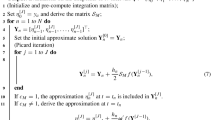Abstract
Explicit parallel two-step peer methods use s stages with essentially identical properties. They are quite efficient in solving standard nonstiff initial value problems and may obtain a parallel speed-up near s on s processors for expensive problems. The two-step structure requires s − 1 initial approximations which have been computed by one-step methods in earlier versions. We now present a self-contained starting procedure using parallel Euler steps in the initial interval. Low order error terms introduced by this step are eliminated by special coefficient sets increasing the order to s after s − 2 time steps. An estimate for the initial stepsize is discussed, as well. Parallel OpenMP experiments with realistic problems demonstrate the efficiency compared to standard codes.
Similar content being viewed by others
References
Butcher, J.C.: The Numerical Analysis of Ordinary Differential Equations (Runge–Kutta and general linear methods). Wiley, New York (1987)
Hairer, E., Nørsett, S.P., Wanner, G.: Solving Ordinary Differential Equations, I. Nonstiff Problems, second revised edition. Springer, Berlin (1993)
Jackiewicz, Z., Tracogna, S.: A general class of two-step Runge–Kutta methods for ordinary differential equations. SIAM J. Numer. Anal. 32, 1390–1427 (1995)
Podhaisky, H., Weiner, R., Schmitt, B.A.: Rosenbrock-type ‘Peer’ two-step methods. Appl. Numer. Math. 53, 409–420 (2005)
Schmitt, B.A., Weiner, R.: Parallel two-step W-methods with peer variables. SIAM J. Numer. Anal. 42, 265–282 (2004)
Schmitt, B.A., Weiner, R., Jebens, S.: Parameter optimization for explicit parallel peer two-step methods, Appl. Numer. Math. 59, 769–782 (2009). doi:10.1016/j.apnum.2008.03.013
Schmitt, B.A., Weiner, R., Podhaisky, H.: Multi-implicit peer two-step W-methods for parallel time integration. BIT Numer. Math. 45, 197–217 (2005)
Verner, J.H.: Improved starting methods for two-step Runge–Kutta methods of stage-order p − 3. Appl. Numer. Math. 56, 388–396 (2006)
Weiner, R., Biermann, K., Schmitt, B.A., Podhaisky, H.: Explicit two-step peer methods. Comput. Math. Appl. 55, 609–619 (2008)
Weiner, R., Schmitt, B.A., Podhaisky, H., Jebens, S.: Superconvergent explicit two-step peer methods. J. Comp. Appl. Math. 223, 753–764 (2009). doi:10.1016/j.cam.2008.02.014
Wright, W.M.: General Linear Methods with Inherent Runge–Kutta Stability. Ph.D. Thesis, The University of Auckland (2003)
Author information
Authors and Affiliations
Corresponding author
Rights and permissions
About this article
Cite this article
Schmitt, B.A., Weiner, R. Parallel start for explicit parallel two-step peer methods. Numer Algor 53, 363–381 (2010). https://doi.org/10.1007/s11075-009-9267-2
Received:
Accepted:
Published:
Issue Date:
DOI: https://doi.org/10.1007/s11075-009-9267-2




